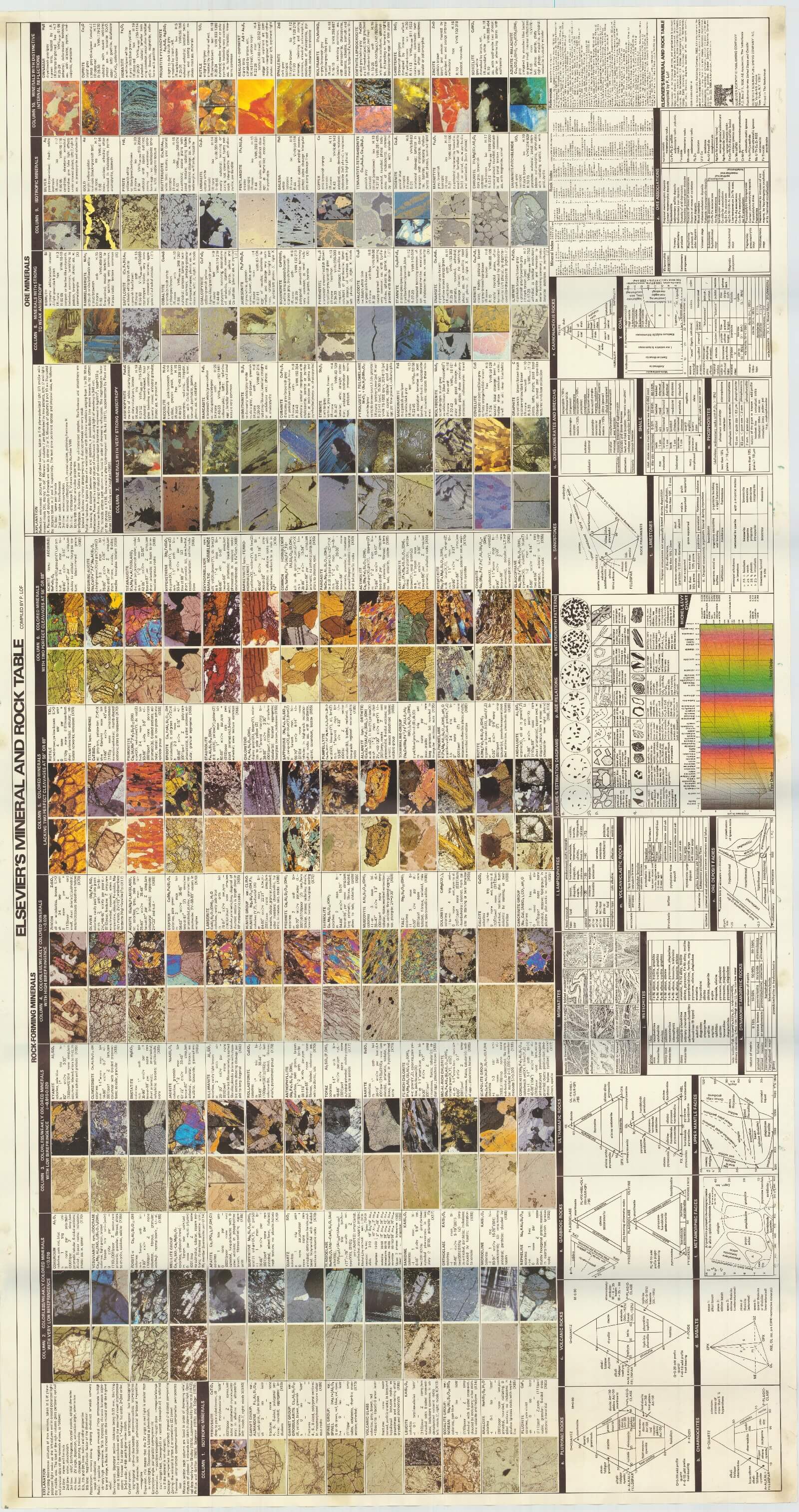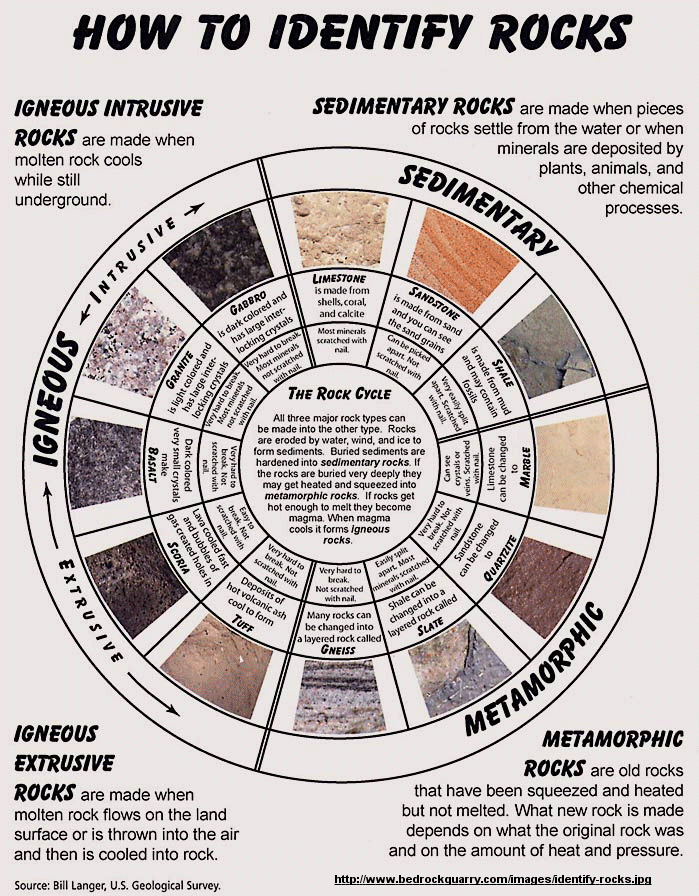It is strongly recommended to the student of this book that he obtain specimens of rock, not labelled, and study their features with a view to naming them. The Table for Identification of Rocks will help in naming them.
It may here be mentioned that the identification of rocks presents peculiar difficulties. Rocks are not definite substances; in some cases, they are mixtures of minerals, while in other cases, they are mixtures of pieces of older rocks. The rock is often so fine grained that it is impossible to distinguish the minerals or the fragments without the aid of the microscope and other laboratory appliances. But, in many cases, the nature of the rock is plainly visible. The student need not feel discouraged if he is not able to “spot” every rock at sight; the most experienced geologist is unable to do this. The following illustrative examples will explain the method of using the Table.
- Consult the Table and note that this specimen comes under Division C. Distinctly and Evenly Crystalline. Try its hardness with the knife; it comes under (6), Hard to Scratch. Note, further, that there are three minerals in this rock; the reddish one is identified as feldspar by its good cleavage and hardness; the grayish-white one as quartz, by its glassy look, hardness, and lack of cleavage; the black mineral as mica, by its shiny appearance, softness and cleavage into thin, elastic sheets, or as hornblende, by its hardness and good cleavage. The rock is granite.
- Study its appearance, and note that it also comes under Division C. Identify the black, or dark, or green mineral as hornblende or pyroxene, by good cleavage and hardness. Note light-colored crystals, hard and with good cleavage, as feldspar. The specimen is diorite, gabbro, or diabase, hard to distinguish from one another. Actually, this specimen is gabbro. Read the description of these three rocks.
- Note its fine-grained appearance; it comes under division B. As it is not scratched with a knife, it is rhyolite, flint, chert, or basalt. Its color is light, and thin flakes are white; therefore, it is rhyolite, flint, or chert. It is rhyolite. See if you can find the glassy round spots of quartz called bird’s eyes. Read description and compare the specimen with it.
- Study the specimen carefully as a whole, and note that it comes under E in the Table. Identify the minerals in it as feldspar, quartz, and either mica or hornblende, the same as in granite, specimen No. 1; this specimen is gneiss.
- Note from the rounded pebbles and grains of quartz, etc., that the specimen comes under F in the Table. The pieces are mostly of the harder minerals and rocks (try with a knife) and feldspar is not noticeable; the pieces are mostly as large as peas or larger. The rock is conglomerate.
Table for Identification or Rocks
A. Glassy in Texture
- Glassy luster; conchoidal fracture. Obsidian
- Resinous or dull, pitchy luster. Pitchstone
- Cellular; very light. Pumice
B. Fine-Grained, or Dull and without Grain
(a) SCRATCHED BY FINGER NAIL
- Strong, clayey odor when breathed upon; greasy feel after long rubbing; does not fizz with acid Clay also Shale
- No clayey odor (marl may have clayey odor); no greasy feel; fizzes with acid. Chalk + Marl
- Same as (2), but does not fizz with acid. Tripolite
- Harder; does not fizz with acid; good cleavage. Gypsum
- Soft; greasy feel; often in scales, like mica, but not elastic. Soapstone
(b) NOT SCRATCHED WITH FINGERNAIL, BUT EASILY WITH KNIFE
- Laminated; clayey odor; usually gray; no fizzing, or very little, with acid. Shale also Slate
- No clayey odor, or very feeble; usually gray; powder, white; fizzes with acid. Limestone
- Same as 2, but fizzes only when acid is hot. Dolomite
- Usually greenish; powder, white; slightly soapy feel; luster, often waxy; sometimes rather hard to scratch with knife; does not fizz with acid. Serpentine
(c) NOT SCRATCHED WITH KNIFE; SCRATCHES GLASS
- Color, light, white in thin flakes; sometimes clayey odor. Rhyolite
- Very hard, scratches steel and feldspar; usually light in color; conchoidal fracture. Flint + Chert
- Not so hard as 1 and 2; color dark; heavy; sometimes with roundish holes or amygdules. Basalt
C. Distinctly and Evenly Crystalline
(a) EASILY SCRATCHED WITH KNIFE
- Fizzes with cold acid. Crystalline Limestone
- Fizzes only with hot acid. Dolomite
- Does not fizz with acid; brilliant cleavage surfaces. Gypsum
- Glassy luster; cubic cleavage; salty taste. Rock Salt
(b) NOT SCRATCHED, OR HARD TO SCRATCH, WITH KNIFE
- Usually light-colored; composed of quartz and feldspar, with often mica or hornblende. Granite
- Same as 1, but no quartz. Syenite
- Dark gray or black; composed of hornblende and feldspar. Diorite
- Dark gray or black; heavy; composed of pyroxene and feldspar. Gabbro + Diabase
- Dark green to black; heavy, composed mostly of hornblende, pyroxene or olivine. Amphibolite + Pyroxenite + Peridotite
- Composed of grains of quartz, more or less rounded. Sandstone + Quartzite
- Same as 6, but with grains of feldspar, etc. Graywacke
D. A Fine-Grained Mass with some large Crystals
- Crystals of quartz and feldspar in a light-colored mass. Quartz Porphyry + Granite Porphyry
- Crystals of feldspar in a light-colored mass. Feldspar Porphyry + Syenite Porphyry
- Crystals of feldspar, hornblende. black mica, etc., in a dark-colored mass; in dikes Lamprophyre etc.
E. In Layers or Sheets, more or less Distinct
- Same composition as granite. Gneiss
- Mica and quartz. Mica Schist
- Green or black, mostly needle-like or bladed hornblende crystals. Hornblende Schist
- Fine-grained; usually gray; often, clayey odor; splits into smooth, even slabs. Slate
- Greasy feel; marks cloth; easily scratched with finger nail. Talc Schist
- Composed of sericite, a variety of mica, often with quartz or carbonates between the layers; usually light-colored and glistening. Sericite Schist
- Harder than talc; smooth; green; powder, white or gray; shines like mica. Chlorite Schist
- Limestone, Shale.
F. Composed of Fragments of Rocks or Minerals
- Rounded pebbles from the size of a pea to boulders. Conglomerate
- Angular pieces. Breccia
- Pieces of volcanic rock. Volcanic Tuff + Volcanic Breccia
- More or less rounded grains, mostly of quartz from the size of pea down. Sandstone
- Same as 4, but with feldspar grains. Arkose
- Gray color; fine-grained; quartz, feldspar, and other minerals and rocks. Graywacke


